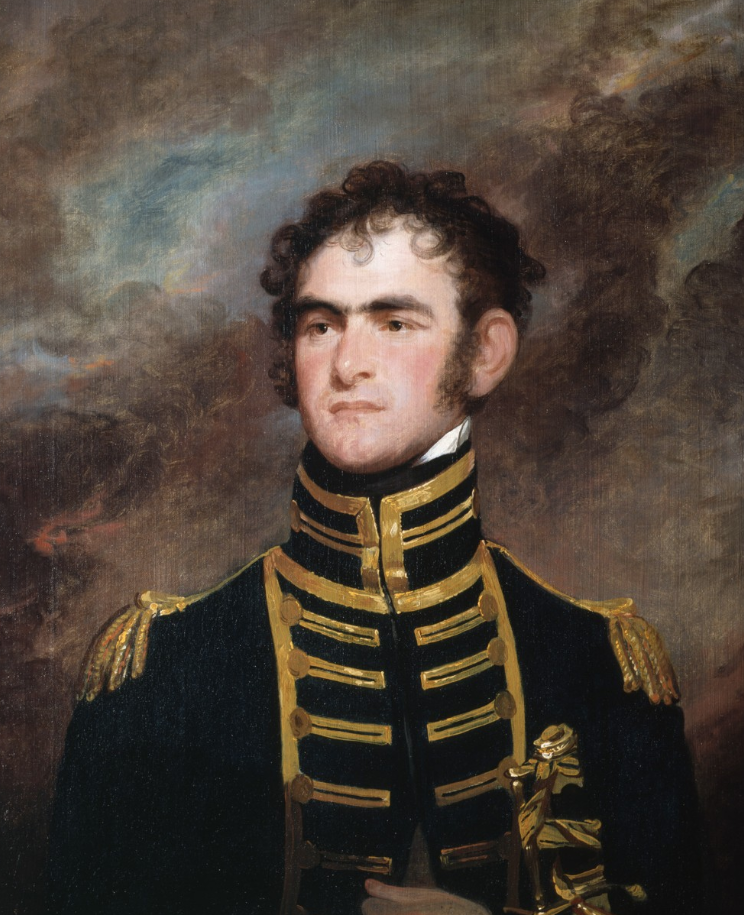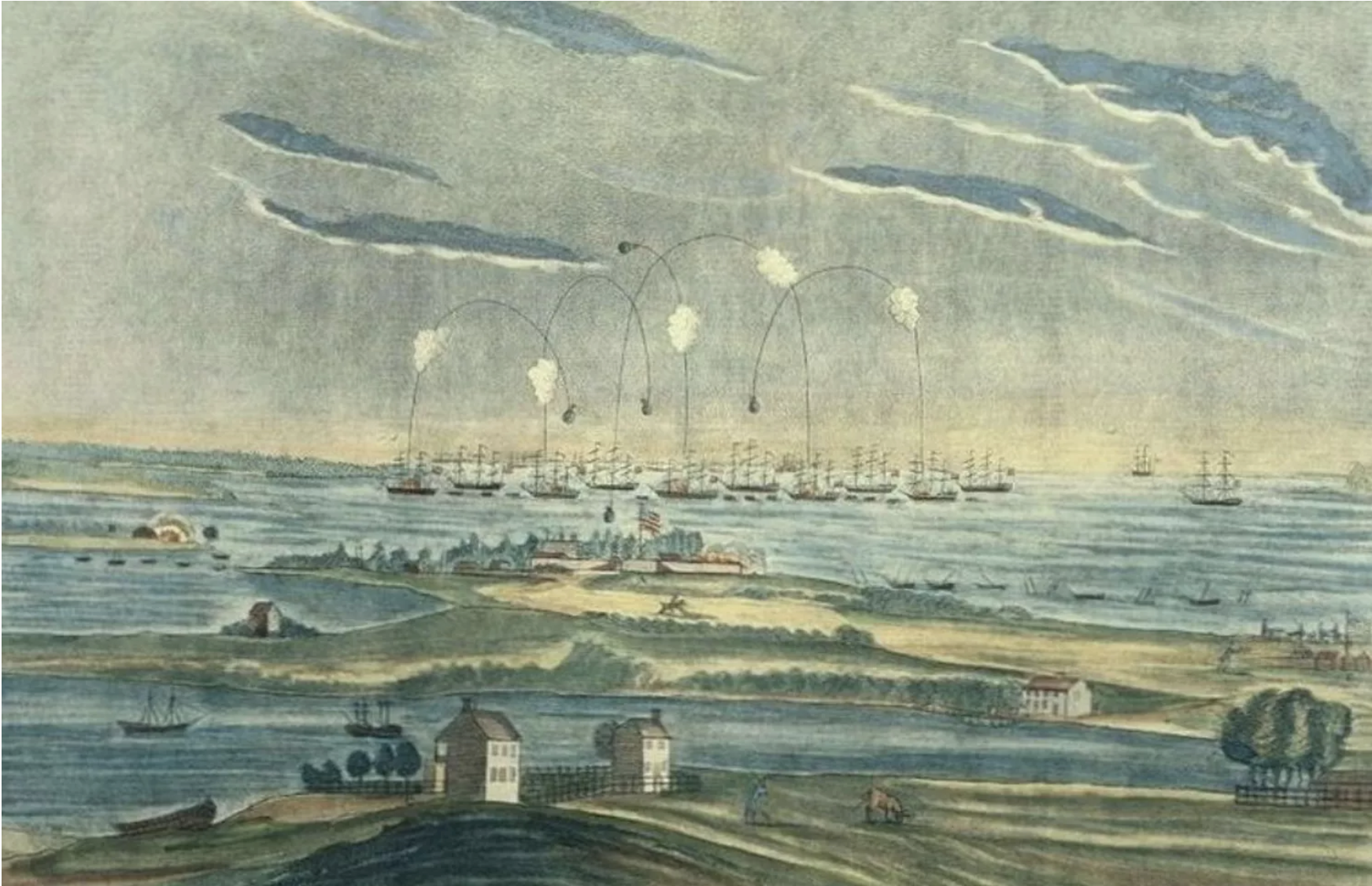Episode 6: First Assignment
“Nothing is to be feared but fear” -Francis Bacon
This is the sixth in a series about the Founder of Sea Girt Robert Field Stockton. Here the 17-year-old plays a major role in the War of 1812.
Robert’s inaugural voyage for the US Navy was aboard the frigate President under Captain John Rogers. He left for New York in February of 1812. Robert’s role as the youngest mate included bringing the captain his belt and pistols. His attitude was eager and polite, but his familiarity in treating the captain was amusing to the crew. The boy looked mature for his age and his confident bearing was surprising. This was the first time the pedigreed young man had been called to service anyone, and he readily admitted it.
Commodore John Rogers, Stockton’s first Captain (Gilbert Stuart 1810)
The frigate escorted merchant ships as the tensions between the 30-year-old United States and Britain were reaching fever pitch. The English needed to feed their war machine in its battle with Napoleon. They had 583 warships, while the Americans had merely 16.
The Royal Navy captured American cargo trading with Europe and impressed sailors into service for Britain. They took almost 9,000 sailors without proper paperwork, especially those who had emigrated to the United States from other British colonies.
President James Madison declared war after long being pressured by war hawks in Congress who were either troubled by the impact on commerce or viewed this interference as a continuation of the bullying that led to the Revolutionary War.
The 44-gun frigate President launched on Robert’s second mission with six extra guns and three other ships as war was declared in June 1812. Fearing Congress would keep ships in port, they sailed out of New York as soon as word of the declaration reached the harbor. The next day Captain Rogers chased a line of enemy vessels and eventually the faster President fired its guns upon the Belvidera. The first shots injured its captain and killed several crew. These were officially the first shots of the war.
The Belvidera tried to escape. It jettisoned anchors, jolly boats, and gig to improve its speed, and the President made chase. They briefly got broadside, but not close enough to land a decisive blow. As they fired, one of their cannons exploded and 19 crew were killed or injured. Rogers’ leg was broken. It would not be the first cannon that would explode while Robert was aboard a ship. Stockton never panicked, He was later lauded for his cool under fire and his ability to complete a list of orders. His hunger to engage the enemy was evident.
After refitting in Boston Harbor. they they captured 23 enemy vessels and Captain Rogers’ infamy grew with the British. He continued the hunt, covering the Gulf Stream from the West Indies to Ireland. The British with the overwhelming advantage in ships, ordered that only multiple ships should engage the President or its sister ship the Congress under Captain Smith. The fast American frigates had the desired effect of disrupting the operations of the Royal Navy, now having to organize escorts all over the Atlantic.
The Royal Navy dispatched several hunting parties with their 74-gun frigates, but they could never engage Commodore Rogers. When finally approaching New York harbor, the President was approached by a 74, but when the British saw they had already hailed the pilot ship their captain declined to take on Rogers. Rogers would be getting a brand new ship. Stockton finished his first assignment with the admiration of his fellow sailors and a new nickname “Fighting Bob”, for his enthusiasm for engagement and coolness under fire.
The war on land was not going as well for the Americans. The US offensive to Canada was stalling in the east. The superior British Navy flooded the St. Lawrence with ships and men. They easily entered the Chesapeake and marched on Washington DC. Rogers and his men were ordered to the area, but their orders did not arrive in time. The city was burned in retaliation for the American’s burning of York (Toronto). The President’s residence, the Capitol, the Senate, and the Supreme Court were set ablaze with no resistance.
As Rogers met in Georgetown with William Jones, Secretary of the Navy, Stockton was by his side. Jones came to like Stockton and asked him to stay with him as an aide until Rogers was given his next assignment. They were awakened in Georgetown a few evenings later by explosions coming from the direction of Alexandria, down the Potomac River. The officers and Jones were shocked and confused as to what was going on.
Stockton declared the only way to know for sure was to give him a horse and he would find out. He rode nine miles to the port and saw that in panic of being fired upon, Captain Dyson had broken his guns and set fire to the magazine of Fort Washington. These were the explosions they had heard. The US retreat with little resistance allowed the British Marines to sack the port which was jammed with blockaded goods. The plundering continued for three days.
Rogers sent his men in fireboats, (barges set ablaze) to ram the British ships, with snipers on the cliffs above, which prevented a second attack on Washington and saved Alexandria from being burned to the ground. He re-raised the American Flag over the city. Jones’ report on the incident mentions Stockton’s role in helping to repel the second invasion in less than 20 minutes, and also his service as aide-de-camp. He noted the Master’s Mate’s “zeal and intrepidity that could not be shaken.”
The shallow waters of the Potomac River, and the time taken to plunder Alexandria played to the US’s advantage.
Baltimore was the next port to defend, and the slow British advance gave the Americans time to prepare. Rogers and his men were given 100 cannon. This was normally infantry work, but all hands were needed, so Rogers’ 650 men were pressed into duty to defend the land march to the city from a dug-in position on Hampstead Hill.
Rogers’ men repelled the ground assault. The British then tried to break the fortification at Fort McHenry from their ships in the Harbor. It rained rockets and cannon fire all night. Francis Scott Key, watching the action later recorded the drama of waiting to see the American Flag still flying over the fort as day broke. The Star Bangled Banner would later be our National Anthem.
The British tried several landings but were repelled by Stockton and sharpshooters from the Pennsylvania Militia. On their way back they found themselves in a swampy area between the enemy and several hundred Americans. Stockton received orders to draw them into combat that night. Stockton went forward into the swamp alone and shot a redcoat as he was reloading. The British advanced on his position and he led them directly into two hundred sailors hidden on either side of the road. The British made a hard retreat.
The Bombardment of Fort McHenry 1814 (public domain)
The defense of Baltimore was the turning of the war. While the superior forces of England did not lose the war, they simply accepted that the cost was too high. They were still distracted by the ongoing war with Napoleon.
Reports in the Niles Register vol. III documented Stockton’s role:
“Much praise is also due to Major Randal commanding officer of a battalion of Pennsylvania riflemen, who was also placed under my command, and who I dispatched with my aid, Mr. Stockton to dispatch a party of men in the enemy’s boats which it was supposed to intend landing near the Lazaretto to take possession of our little three-gun battery. Mr. Stockton on his return reported to me in very high terms the zeal and gallantry displayed by the major and his corps on the occasion…To Master’s Mate Stockton, my aid, I am greatly indebted for the zeal and promptitude with which he conveyed my orders from post to post wherever I had the occasion to communicate, although in some instances he had to pass through showers of shells and rockets.”
In December of 1814, Robert Field Stockton was promoted to Lieutenant.
Next, the Barbary pirates.
Drawn from A Sketch of the Life of Robert Field Stockton by Samuel Bayard 1853, Naval records and National Park Service History of Fort McHenry


